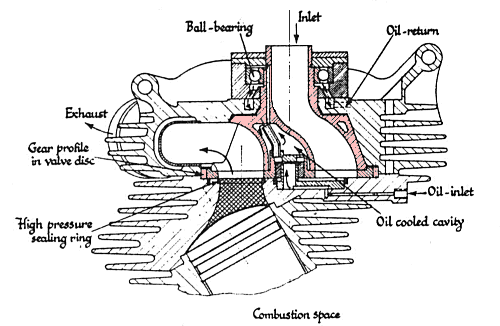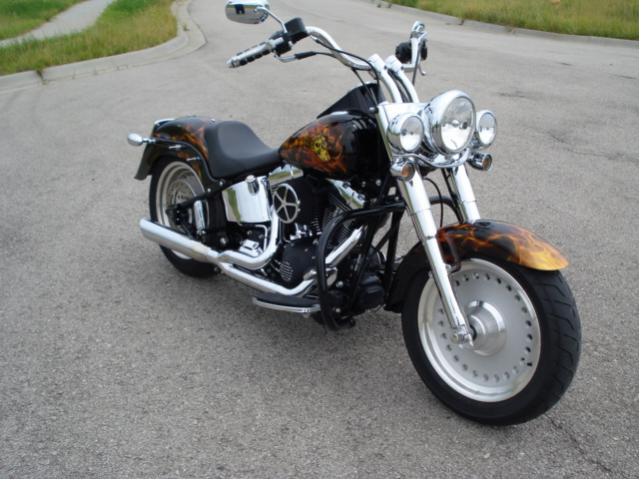For riders in cold-weather regions, it's
almost time to unpack your bike. If your motorcycle has spent a long
winter's night out of service, the following are some points to consider
when you begin to get it ready for the road. We focus here on items
that may require special attention after extended storage
and things which should get attention now to avoid interrupting the
riding season. Your owner's manual will have a checklist for a standard
service.
 Valves: The manual says to adjust them
when the engine is cold. When will it be colder? Give the cam lobes a
shot of oil (the old stuff has long since run off) when you are done. torque the cylinder head too.
Valves: The manual says to adjust them
when the engine is cold. When will it be colder? Give the cam lobes a
shot of oil (the old stuff has long since run off) when you are done. torque the cylinder head too.Battery: If it spent the winter well charged, as with a Battery Tender or a regular trickle charge, then it's is probably ready to go. Give it a regular service (fluid level and slow charge) and send it on its way. If it was neglected all winter, give it the same service and check it. If it comes out looking a bit sickly, replace it before it causes problems. Be certain the vent tube is connected and properly routed.

Oil: If you changed the oil immediately before you stored it, it is probably ready to rumble. Fresh oil can be contaminated by water, which will give it a milky appearance when it is first run. If you didn't change oil before storage, replace it now. Otherwise, those normal contaminants have been joined by a measure of water, a recipe for corrosion. Change the filter unless the it was fresh. Use a torque wrench on that drain plug.
Fuel: If you left your tank full (a good way to avoid rust), the fuel
has probably stratified, unless you used a fuel stabilizer. Before
turning on your petcock and letting fuel into the carb, disconnect the
fuel line and drain the tank completely. (Pour the old gas in your
car--or your neighbor's.) This is a good time to clean your fuel filter
and look inside the tank for rust. If you didn't drain your carb float
bowl(s) before storage, pull them off now and take a look. If the inside
has something that looks like varnished cottage cheese, you probably
have clogged jets, too. Carb cleaner might help, but you might need new
jets and a professional unclogging as well.
Engine: A shot of oil in each spark plug hole followed by a couple of spins of the engine with the plugs removed will protect the cylinder walls and rings during those first few revolutions. When you pull the plugs, check the gaps too. If you haven't serviced it during the winter, the rest of those engine service items (air filter, carb synch, drive-line fluids, etc.) should be attended to as well.
Brakes: This is a good time to install fresh fluid—after your old stuff has spent all winter soaking up water and is at its spongiest. You definitely should do it if you skipped it during the last year or two. Check the pads or shoes too. If they are "sort of" thin, get new ones now.
Suspension and steering: Prop the front wheel off the ground, sit in front of the bike and grasp the fork lowers. Move them forward and back to feel for steering-head looseness. If you feel any movement or clunking from the steering head, tighten it properly. Have you changed fork oil recently? Is a fork seal leaking, even a teensie-weensy bit? If so, take care of it now.
 Routine stuff: Before riding, you should check over all those items on your normal ride check list: tire pressure and condition, wheel true, spoke tension, wheel bearing condition, control function, lubrication
and adjustment, lights, sprocket and chain condition, etc. Look for
leaks anywhere there is fluid. Take time and a couple of wrenches and
check the tightness of every fastener you can reach. Pay particular
attention to anything that can hurt you—brake lever pivot bolts, axle
nuts, drain plugs, etc. Your owner's manual will have a complete list of
points to check before riding. Or if you don't have one (ask your
dealer or the manufacturer), you can use the T-CLOCK checklist
created by the Motorcycle Safety Foundation as an outline. (T-CLOCK
stands for Tires and wheels, Controls, Lights and electrics, Oil and
fluids, Chassis, Kickstand.)
Routine stuff: Before riding, you should check over all those items on your normal ride check list: tire pressure and condition, wheel true, spoke tension, wheel bearing condition, control function, lubrication
and adjustment, lights, sprocket and chain condition, etc. Look for
leaks anywhere there is fluid. Take time and a couple of wrenches and
check the tightness of every fastener you can reach. Pay particular
attention to anything that can hurt you—brake lever pivot bolts, axle
nuts, drain plugs, etc. Your owner's manual will have a complete list of
points to check before riding. Or if you don't have one (ask your
dealer or the manufacturer), you can use the T-CLOCK checklist
created by the Motorcycle Safety Foundation as an outline. (T-CLOCK
stands for Tires and wheels, Controls, Lights and electrics, Oil and
fluids, Chassis, Kickstand.) Spares kit: If you haven't done so already, why not make up a spares kit for on-the-road problems you are capable of handling
yourself? This might include fuses, chain master link, tire tubes
and/or patch kit, headlight bulb, instrument bulb, a bit of wire, some
nuts, duct tape, etc. You might build a first-aid kit too, with an eye
on abrasions, insect stings, and other likely on-the-road adventures.
Put it all in a waterproof package that you can take with you when you
are traveling farther than the county line.
Spares kit: If you haven't done so already, why not make up a spares kit for on-the-road problems you are capable of handling
yourself? This might include fuses, chain master link, tire tubes
and/or patch kit, headlight bulb, instrument bulb, a bit of wire, some
nuts, duct tape, etc. You might build a first-aid kit too, with an eye
on abrasions, insect stings, and other likely on-the-road adventures.
Put it all in a waterproof package that you can take with you when you
are traveling farther than the county line.
We anticipate the weather answering our prayers and wish you a great riding season!
Enjoy the Ride,
LRS Team
Article From: Motor Cycle Cruiser
Enjoy the Ride,
LRS Team
Article From: Motor Cycle Cruiser
Related Articles
How to Service a Motorcycle Battery
Valve Adjustment Simplified
Motorcycle Brake Inspection & Service
The Magic Bag
How to Service Steering-Head Bearings
How to Service Spark Plugs
How to Change a Motorcycle's Oil
Preparing Your Bike for Winter Storage
How to Replace Fork Seals
The Pre-Ride Motorcycle Inspection
Tires: The Sticky Facts & Top Tips
Tires: Inflation vs. Suction
Motorcycle Detailing
How to Service a Motorcycle Battery
Valve Adjustment Simplified
Motorcycle Brake Inspection & Service
The Magic Bag
How to Service Steering-Head Bearings
How to Service Spark Plugs
How to Change a Motorcycle's Oil
Preparing Your Bike for Winter Storage
How to Replace Fork Seals
The Pre-Ride Motorcycle Inspection
Tires: The Sticky Facts & Top Tips
Tires: Inflation vs. Suction
Motorcycle Detailing


No comments:
Post a Comment